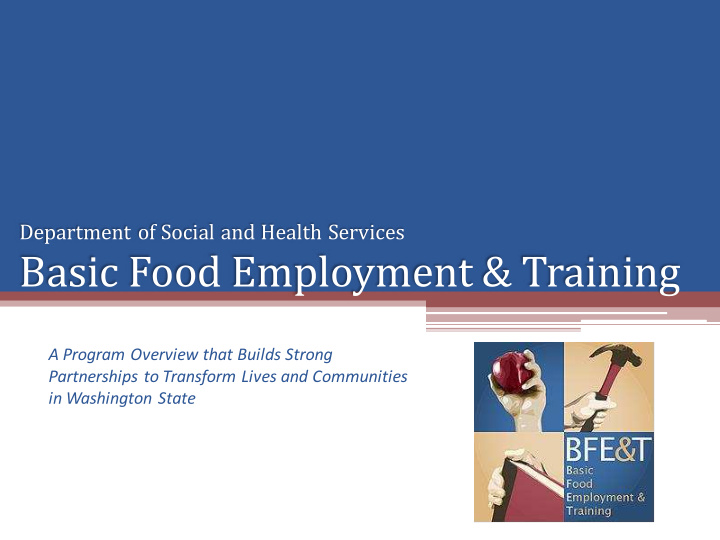



Department of Social and Health Services Basic Food Employment & Training A Program Overview that Builds Strong Partnerships to Transform Lives and Communities in Washington State
What is the BFET program? • The Basic Food Employment & Training program provides employment, education, and training services to Basic Food recipients. • The goal of the BFET program is to assist Basic Food recipients in obtaining a livable wage leading towards self-sufficiency.
What is the BFET program? • The BFET program is a 50/50 reimbursement program. ▫ Promotes partnerships among agencies within the community ▫ Promotes collaboration among BFET providers ▫ Leverages partner agencies’ strengths ▫ Diversify the revenue streams to assist BFA recipients In FFY 2014, $13.8 million of local, state and other funds was matched by the Federal government.
Services Provided to BFET Participants ▫ Employability assessment ▫ Case management ▫ Job readiness training ▫ Basic skills/ESL training (literacy, math, vocational ESL, GED preparation) ▫ Vocational training ▫ Job search assistance, job placement, and post- employment support services
Support Services ▫ Transportation ▫ Safety clothing ▫ Housing and utility assistance ▫ Child care subsidy ▫ Personal hygiene and grooming ▫ School supplies ▫ Tools and equipment needed to secure employment
Brief History of BFET • BFET began as a pilot program in 2005 in the White Center community. • During 2007-2012, BFET program grew from King county to be a statewide program. Year # of BFET Providers # of BFET Participants 2005 6 X 2006 10 183 2007 15 381 in 4 th quarter 2,142 in 1 st quarter 2012 53 10,584 in 4 th quarter 2014 61
The Impact of BFET • An average of 53% employment rate for 2005 – 2012 ▫ 61% employment rate for 2012 • BFET participants verses BFA only ▫ During the recession in 2008, BFET participants lost their jobs at a much slower rate that BFA only recipients. ▫ BFET participants were 34% more likely to be employed that BFA only in 2009. In 2010, the figure was 42%. ▫ BFET participants earn 9.5% more than BFA only in 2009. In 2010, the figure is 9.3%.
BFET or WorkFirst Similarities between BFET & WorkFirst Similar support services Approved activity for childcare services Education goals remain the same when transitioning from WorkFirst to BFET Similar goal: to help clients become self-sufficient through employment and training Differences between BFET & WorkFirst BFET WorkFirst Voluntary participation program Mandatory participation program Client decides what activities they DSHS decides what activities the client participate in will participate in No time limit 60 month time limit
Your Role in BFET
Your role in BFET • Who is eligible for BFET? • Who is a good candidate for BFET? ▫ Only SNAP recipients are eligible ▫ Community college student for BFET (transfer degrees or 4-year ▫ Non-TANF recipient degrees are not approved programs of study) ▫ Unemployed or under-employed individual ▫ DCA recipient ▫ TANF applicant who desires to save their 60 months ▫ Any adult desiring employment, but must first improve their reading, writing and math skills (including LEP)
Your role in BFET • What can you do? ▫ Discuss the benefits of BFET with BFA recipients ▫ Provide BFET brochure to BFA recipients ▫ Discuss providers to contact
Your role in BFET as a provider • 10- 501: The “Reverse Referral” ▫ The Reverse Referral happens when a contractor enrolls a person in BFET prior to BFA approval. ▫ The Reverse Referral makes the applicant an eligible student per WAC 388-482-0005(3)(j)(ii).
Your role in BFET
We need contractors!!!
Additional Resources • Dedicated BFET email address ▫ SWBFETPOLICY@dshs.wa.gov
Recommend
More recommend